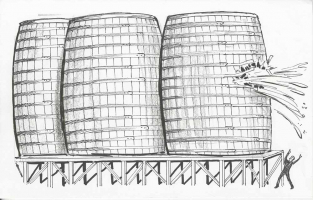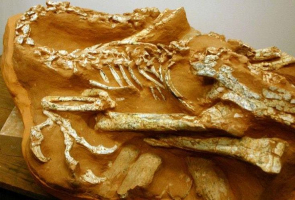Top 10 Bizarre Archaeological Hoaxes That Fooled Everyone
Unsavory characters who are want their 15 minutes of fame or, worse still, who want to change history to fit their worldview or outlandish ideas are nothing ... read more...new to the field of archaeology or the sciences as a whole. Individuals in the 1800s were made of a different material and appeared to enjoy tampering with their fellow people in particular. Here are ten of the most bizarre pseudo-archaeological claims, including ones about old, fossilized giants, papier-mâché mummies, and fake antique tablets.
-
In October 2000, Pakistani authorities questioned a man who was trying to sell a mummy for $11 million on the illegal market. When questioned, the man stated that an Iranian man had found the mummy after an earthquake and had given it to him. The mummy was said to have been a Persian princess. She was found in a wooden tomb that included cuneiform inscriptions that claimed she was linked to the legendary King Xerxes. While both countries claimed ownership of the "finding," there were momentary tensions between Iran and Pakistan, but they would soon pass.
The mummy was eventually brought by Pakistani officials to the National Museum in Karachi, where it underwent rigorous testing to establish its legitimacy. The mummy was shown to be a counterfeit after CT scans, examination of the ancient Persian writing, and carbon dating, and what's worse was how old the body was.
The body belonged to a 4-foot-7 woman who was above 21 and most likely passed away around 1996. Officials initially suspected the woman had been murdered, but after re-questioning the two men who had been trying to sell the mummy, they came to the conclusion that it was more likely that they had taken the body from a cemetery illegally and removed the woman's internal parts.

Image by Aakash Ashraf via pexels.com 
Image by Aa Dil via pexels.com -
A polished sandstone pebble was found in a West Virginia burial mound that was 2,000 years old in 1838. Scholarly analysis of the 25 characters carved into the pebble suggested that four of the markings appeared to be from Ancient Greek, four from Etruscan, five from runic, six from ancient Gallic, seven from old Erse, ten from Phoenician, fourteen from old British, and sixteen from Celtiberic, and some from Hebrew as well. Additionally, three completely different translations of the text on the stone were proposed by the physician RJ Farquharson in the 1870s.
“Thy orders are laws, thou shines in thy impetuous clan, and rapid as the chamois.”
“The chief of emigration who reached these places (or island), has fixed these decrees forever.”
“The grave of one who was murdered here; to revenge him may God strike his murderer, suddenly taking away his existence.”
Nevertheless, at the same time, MC Reed, an antiquarian, hired a law student, a chemist, and a professor to each create 20 or more characters that had nothing to do with any alphabet or symbols they could quickly recollect. Each person's given characters resembled Old World alphabets as a result, and Reed deduced from this research that the Grave Creek Stone could only be a counterfeit.
Image by Adi Shefer via pexels.com 
Image by Pixabay via pexels.com -
The story of an amateur archaeologist named Fujimura Shin'ichi being caught on camera putting phony relics at an archaeological site surfaced early on November 5, 2000. The Kami Takamori site, which predates sites in Europe and Africa, the continent that gave rise to civilization, was at the time thought to be the oldest Early Paleolithic site on Earth.
They would have changed the course of human history if the objects they had contained had been shown to be true. This wasn't the case, though, and once video of Fujimura's actions spread, suspicion was raised at every dig site he was associated with in Japan.
According to speculation, Fujimura hid more than 180 relics between 1976 and 2000; as a result, it was commonly believed that humans first appeared in Japan more than 500,000 years ago. The situation is complicated by Fujimura's fraud, which has a significant negative impact on Japanese archaeology. Although there is evidence that humans existed in China and that land bridges connected the island of Japan at least twice in the previous 700,000 years, there is currently no proof that humans existed in Paleolithic Japan.

Image by Belle Co via pexels.com 
Image by Aleksandar Pasaric via pexels.com -
In 1909, two Smithsonian-funded archaeologists made the same claim. Today, if someone claimed to have found evidence that ancient Egyptians had lived in the United States thousands of years ago, they would be met with plenty of skepticism (well, maybe not, considering there are still people who believe the Earth is flat). Two archaeologists, Professor SA Jordan and GE Kinkaid, reportedly claimed to have discovered proof of an ancient Egyptian colony inside the Grand Canyon, according to an article published in the Arizona Gazette on April 5.
The two asserted to have discovered tablets with Egyptian hieroglyphs that they said proved the settlement was older than Ramses, as well as a number of unusual caves sculpted by human hands. In 1909, two Smithsonian-funded archaeologists made the same claim. Today, if someone claimed to have found evidence that ancient Egyptians had lived in the United States thousands of years ago, they would be met with plenty of skepticism (well, maybe not, considering there are still people who believe the Earth is flat).
Two archaeologists, Professor SA Jordan and GE Kinkaid, reportedly claimed to have discovered proof of an ancient Egyptian colony inside the Grand Canyon, according to an article published in the Arizona Gazette on April 5. The two asserted to have discovered tablets with Egyptian hieroglyphs that they said proved the settlement was older than Ramses, as well as a number of unusual caves sculpted by human hands.

Image by Paul IJsendoorn via pexels.com 
Image by Pixabay via pexels.com -
Three statues of Terracotta warriors supposed to have been produced by the Etruscan civilisation in the fifth century were proudly displayed by the Metropolitan Museum of Art between the years 1915 and 1921. The entire collection was made up of less-than-elaborate fakes, which the museum's curator was unaware of (and who was extremely proud of the sculptures).
Two young guys by the names of Riccardo Riccardi and Alfredo Fioravanti perpetrated the fraud. These two men were accomplished visual artists from Italy. Riccardo was the most talented of his brothers, even though his father and brothers were also accomplished forgers of pottery.
The initial statue was made by Riccardo and his collaborator Alfredo, but because of a disagreement about placing, the statue turned out to be too big for their kiln, and they broke off its arm. The couple used the description provided by the ancient historian Pliny as a starting point for a massive Terracotta warrior head after successfully tricking the museum into purchasing their statue. A 25-foot-tall statue of the deity Jupiter from a bygone Roman temple was recorded by Pliny. The head was raised to a height of four and a half feet by Riccardo and Alfredo.
Although the museum didn't suspect anything, the two started designing their biggest deception yet: an enormous 8-foot-tall Terracotta warrior. Tragically, Riccardo was killed when he was knocked off his horse. Two of Riccardo's cousins would finish the 8-foot-tall Terracotta warrior in place of the former. The statue was bought by the Met. in 1921 for an amount that, after inflation, is said to have been close to $5 million. Yet there was something odd with the genitalia of this statue. The forger had shaped the genitals after his own, and many of the local Italian women recognized them as Riccardo's.
Even so, it would take years before the sculptures' forgery was discovered. Following a series of scientific analyses, it was discovered in 1960 that the sculptures' glazes contained substances that had not been in use since the 17th century.

Image by Pixabay via pexels.com 
Image by Pixabay via pexels.com -
A style of polished quartz skull carving first appeared in the art market in the 1860s. The British Museum in London, the Quai Branly Museum in Paris, and the Smithsonian Institution in Washington, DC all house these skulls, which are thought to have been created before the Spanish invasion in the 16th century.
Although specialists had their suspicions about the authenticity of the skulls as early as the 1930s, they were later found to be a complete fake. They proved the skulls were unquestionably from post-Columbian times by using scientific tools.
Yet, if you believe Dan Aykroyd, who has gone so far as to produce a vodka product housed in a glass bottle like one of the crystal skulls, you may think that these enigmatic objects are actually 5,000 to 35,000 years old. When asked about the skulls, Aykroyd stated that although their provenance was debatable, everyone agreed that they were potent symbols of enlightenment and hope for a brighter future. He also stated that the skulls were carved without the use of any tools and took hundreds of years to complete.

Image by Flo Dahm via pexels.com 
Image by Pixabay via pexels.com -
The Mississippi Department of Archives received a few nice archaeological discoveries in the early 1920s, including several Native American artifacts and what appeared to be a "bonafide" Egyptian mummy. The mummy was tiny, prompting speculation that it could have been a kid. It remained on display until 1967, when Gentry Yeatman, a medical student, requested permission from the museum to study it for a research project. Yeatman found out the mummy was a fake when his request was approved.
Yeatman noticed the shredded newspaper shards stuck to the mummy's back as the first indication that things wasn't quite right. The student then used an x-ray machine to examine the object and discovered that it was made of papier-mache over a wooden frame that was kept together by nails and animal bones.
The two newspapers with print still legible on their pages are proof that the fake wasn't even done well. One of them was from a German-language publication, while the other was from the 1898 edition of the Milwaukee Daily Journal.
Image by Tom Fisk via pexels.com 
Image by Tom Fisk via pexels.com -
After a heated religious argument with a revivalist preacher, George Hull—a cigar maker and ardent atheist—would go on to launch one of the most well-known hoaxes in American history in 1869. With the preacher's assertions that giants roamed the Earth in Biblical times, Hull claimed to have been "flabbergasted" and decided to make his own giant in an effort to disprove his religion. Creating relationships with a Chicago marble trader and a farmer named William "Stub" Newell in Cardiff, New York, cost Hull two years of his life and $3000.
The statue was buried by Newell and Hull on their property. Later, Newell persuaded laborers to dig a well where they allegedly found the remains of a 10-foot-tall figure. Soon after the "find" became public knowledge, hundreds of curious onlookers and amateur archaeologists swarmed to the location. The statue was displayed for viewers to make their own judgments, and despite the obvious poor quality of the statue, many were struck by the idea that it might have been real.
George Hull, a cigar maker and fervent atheist, got into a heated religious debate with a revivalist preacher that led to the beginning of one of the most well-known hoaxes in American history in 1869. Hull claimed to have been "flabbergasted" by the preacher's claims that giants inhabited the Earth in Biblical times and made his own giant in an effort to refute his faith. Hull lost two years of his life and $3,000 by developing friendships with a Chicago marble salesman and a farmer named William "Stub" Newell in Cardiff, New York.
Image by Nextvoyage via pexels.com 
Image by jimmy teoh via pexels.com -
Jacob Gass, a Lutheran minister and Swiss immigrant, found a group of three tablets inside a Native American burial mound at the Cook Farm in Davenport, Iowa, in 1877 and 1878. The tablets included a wide variety of languages and showed images from hunting, cremation, and an astrological table. The tablets were initially hailed as the missing connection between Native Americans and people in the ancient world, indicating that their mounds had been constructed by an older, more sophisticated culture of settlers by eminent historians like Spencer Bird of the Smithsonian Institution.
Later, when they were revealed to be complete forgeries, Jacob Gass's credibility as an archaeologist was called into question. According to some, Gass didn't carry out the forgeries; rather, he was the target of xenophobic attempts by envious coworkers who didn't like the thought of a foreigner working for their organization to exclude him from the Davenport Academy. This theory was eventually refuted by the revelation that Gass frequently traded in imitation Native American pipes, but it has been suggested that Gass was unaware of the fakes and that his own relatives convinced him to accept them.

Image by Robert Stokoe via pexels.com 
Image by Denis Linine via pexels.com -
A human skull was allegedly discovered in the depths of a mine on Bald Mountain in Calaveras County, California, in July 1866, according to workers there. It was claimed that the skull was 130 feet below the surface, beneath a layer of solidified magma. The skull was given by mine owner James Mattison to a local businessman, who then gave it to a doctor in the area. Finally, it was in the possession of JD Whitney, a professor at Harvard University and the state geologist of California. Even when concerns about the validity of the skull's provenance were raised, Whitney remained convinced that it belonged to a man of the Pliocene era.
Even JD Whitney's successor resisted calling the skull a fake, and it took years before the fraud was finally exposed. The skull was inspected and found to be too contemporary to be from the Pliocene period. Moreover, the dirt that covered it could not have come from the mine, indicating that it had been planted there. After speaking with a local pastor, a San Francisco newspaper deemed the skull to be a fraud as early as 1869. The miners had been joking about planting the skull as a joke on Professor Whitney when the minister overheard them.

Image by Jessica Lewis Creative via pexels.com 
Image by Roberto Nickson via pexels.com































